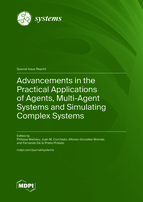Advancements in the Practical Applications of Agents, Multi-Agent Systems and Simulating Complex Systems
A special issue of Systems (ISSN 2079-8954). This special issue belongs to the section "Complex Systems".
Deadline for manuscript submissions: closed (31 January 2023) | Viewed by 32598
Special Issue Editors
Interests: artificial intelligence; multi-agent systems; individual based simulation; agent based computational economics; game theory
Special Issues, Collections and Topics in MDPI journals
2. Air Institute, IoT Digital Innovation Hub, 37188 Salamanca, Spain
3. Department of Electronics, Information and Communication, Faculty of Engineering, Osaka Institute of Technology, Osaka 535-8585, Japan
Interests: artificial intelligence; smart cities; smart grids
Special Issues, Collections and Topics in MDPI journals
Interests: smart cities; IoT; Industry 4.0; machine learning; artificial intelligence natural language processing; computational technologies; sentiment analysis
Special Issues, Collections and Topics in MDPI journals
Interests: artificial intelligence; multi-agent systems; cloud computing and distributed systems; technology-enhanced learning
Special Issues, Collections and Topics in MDPI journals
Special Issue Information
Dear Colleagues,
The relationship between individuality and aggregation is an important topic in complex systems science, as both aspects are facets of emergence. This problem has generally been addressed by adopting a classical individual- versus population-level approach, in which boundaries emerge in segregated communities: the existence of boundaries delimiting and interconnecting aggregates. It is therefore crucial to define the properties of complex systems correctly, such as generic agent-based models, with which to simulate communities situated in grid- and scale-free network environments. To do this, complexities may be resolved through simulation, modeling and analysis techniques, which help provide confidence regarding the behavior of such systems, especially of those operating in dynamic environments or under unexpected constraints. Moreover, modeling and simulation help reduce the risks and costs involved in the design and development of validation tests.
Understanding the emergent behaviors of complex systems, and ensuring their correct performance in different environments, will allow for their evolution, as well as that of the methodologies integrated in them.
Although various methodologies are being used for the development of Complex Systems Simulation, one of the most widely adopted approaches is based on the agent paradigm, which may be used to create simulations for dynamic continuous time systems and discrete event systems. Agent-based systems may be applied in all sorts of areas, including home automation, industry, smart cities and automotive sectors.
This Special Issue invites researchers to submit original quality studies regarding the domain of Complex Systems Simulation, and urges them to address its main sub-disciplines, which include, but are not limited to, the following:
- Complex Systems
- Simulating Complex Systems
- Simulation, Modelling and Analysis Techniques
- Reasoning in Complex Systems
- Mathematical Modeling
- Distributed Problem Solving
- Agent-Based Simulation
- Multi-Agent Systems (MAS)
- Virtual Agent Organisations (VAO)
- IoT and MAS
- CPS and MAS
- IoT, Smart Cities, Industry 4.0
- Digital Twins
- Ambient Intelligence
The deadline for papers from PAAMS is 28th February 2023.
Prof. Dr. Philippe Mathieu
Prof. Dr. Juan M. Corchado
Dr. Alfonso González-Briones
Dr. Fernando De la Prieta
Guest Editors
Manuscript Submission Information
Manuscripts should be submitted online at www.mdpi.com by registering and logging in to this website. Once you are registered, click here to go to the submission form. Manuscripts can be submitted until the deadline. All submissions that pass pre-check are peer-reviewed. Accepted papers will be published continuously in the journal (as soon as accepted) and will be listed together on the special issue website. Research articles, review articles as well as short communications are invited. For planned papers, a title and short abstract (about 100 words) can be sent to the Editorial Office for announcement on this website.
Submitted manuscripts should not have been published previously, nor be under consideration for publication elsewhere (except conference proceedings papers). All manuscripts are thoroughly refereed through a single-blind peer-review process. A guide for authors and other relevant information for submission of manuscripts is available on the Instructions for Authors page. Systems is an international peer-reviewed open access monthly journal published by MDPI.
Please visit the Instructions for Authors page before submitting a manuscript. The Article Processing Charge (APC) for publication in this open access journal is 2400 CHF (Swiss Francs). Submitted papers should be well formatted and use good English. Authors may use MDPI's English editing service prior to publication or during author revisions.









